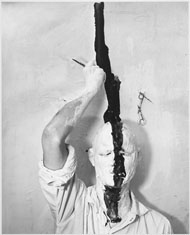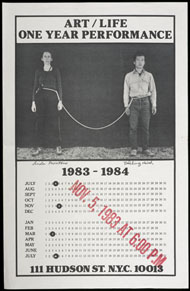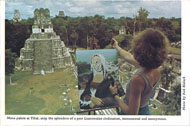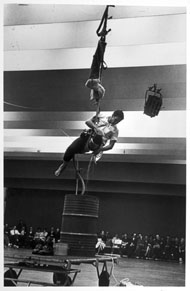 |

 |
 |
Image from Selbstbemalung II (Self painting II), Günter Brus, 1964
© Günter Brus. Courtesy Galerie Heike Curtze
|
 |
This exhibition surveys the variety of ways that artists in the 20th century have documented and represented performance-based art using nearly every medium imaginable—from photographs, films, video, and audio recordings, to notes, drawings, scores, books, and objects. The image here records a performance by Günter Brus, a member of a group of Austrian artists called the Vienna Actionists. The production of striking photographic imagery became the goal of many Actionist performances, which often combined the explosive energy of abstract expressionist painting with imagery suggestive of primitive rituals.
These attempts to transpose the dynamic and experiential qualities of performance into documentary and archival media have influenced the field of art as a whole and have posed challenges to established notions of the art collection and the archive. These documents are often exhibited as works of art, although the artists have rarely accepted such documents as a sufficient record of their work. Drawn primarily from the collections of the Research Library at the Getty Research Institute, this exhibition presents artists' different approaches to developing lasting records of their performance-based works.
|
 |

 |
 |
Poster from Art/Life One Year Performance 1983–1984, Tehching Hsieh and Linda Montano, 1983
© Tehching Hsieh, Linda Montano
|
 |
 |
Performances of extremely long duration pose strategical challenges, as well as opportunities, for documentation and display. For Art/Life One Year Performance 1983–1984, artists Tehching Hsieh and Linda Montano were tied together by a length of rope for an entire year. They were never allowed to be more than eight feet away from one another, but they also agreed not to touch for the extent of the performance.
Receptions held at three month intervals allowed the artists to "exhibit" the progress of the work, while time-stamped snapshots documented the artists' daily routines. By shaving their heads at the beginning of the performance, the artists effectively used their hair as another documentary medium, registering the passage of a year as it grew.
|
 |
 |

 |
 |
Journal of the Identical Lunch, Alison Knowles, 1971
© Alison Knowles
|
 |
Sometimes a single project can lead to the creation of artworks in multiple media by multiple artists. The Identical Lunch developed after Philip Corner noticed that his studio mate, Alison Knowles, ate the same meal at the same restaurant every day. This ritual—ordering a tuna sandwich with butter and lettuce, no mayo, and a cup of soup or glass of buttermilk at the Riss Diner—became the score for a performance, which Knowles then asked other artists to perform.
Journal of the Identical Lunch is Knowles's compilation of those individual artists' widely varying performances, written and sometimes photographed by each performer either during or just after the ritual. Knowles later used images from some of these performances to create limited-edition screenprints.
|
 |

 |
 |
Mona paints at Tikal, atop the splendors of a past Guatemalan civilization, monumental and anonymous, Suzanne Lacy, 1977–1978
© Suzanne Lacy
|
 |
 |
Documenting Suzanne Lacy's travels through Europe, the United States, and Latin America, Travels with Mona depicts the artist visiting great historical monuments while in the process of completing a paint-by-numbers painting of the Mona Lisa.
The images are presented as a fold-out set of postcards, with an accompanying text by art historian Arlene Raven, who notes that "A performance artist speaks but does not generally paint canvases. In this journey, a performance about tourism, imitation, art, artists, art objects, women and culture, she seeks the promises of art long ago whispered to Mona (is that why she's smiling?)—visibility, acknowledgement, fortune, even immortality. Under these circumstances, it is best to have a Famous Painting by a Great Artist along."
|
 |
 |

 |
 |
Image from Elgin Tie, Robert Rauschenberg, 1964. Photo: Hans Malmberg, Nordiska museet, Sweden
© Robert Rauschenberg, licensed by VAGA, New York, NY
|
 |
Photographers of performance sometimes produce powerful imagery that, in addition to recording the details of a live event, also function strongly and independently as photography.
This image from Robert Rauschenberg's performance of Elgin Tie is an example of artists using photographs that appear to depict key moments in a performance. Many of these photographs have been widely reproduced, thus becoming canonical and emblematic images of the performance.
|
 |
|
Close Radio was a weekly series of experimental radio broadcast on Los Angeles station KPFK from 1976 to 1979.
You can listen to Close Radio online, on your phone, or subscribe to a podcast.
Listen to Close Radio
|
 |
|
 |
|